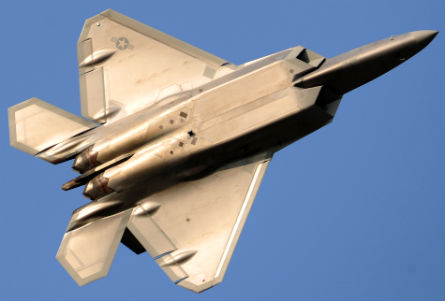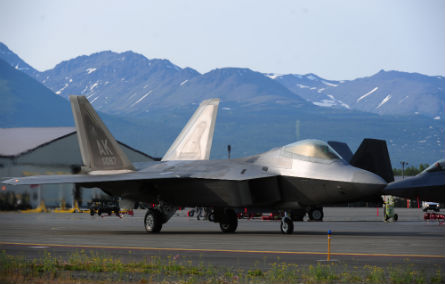A number of pilots and engineers are not convinced that the US Air Force has found the root cause of the Lockheed Martin F-22 Raptor's oxygen woes despite the service officially naming the Combat Edge upper pressure garment and its associated systems as the culprits.
"There's one thing I know for certain: The Combat Edge isn't the culprit," one F-22 pilot says. "But they're trying to show positive momentum."
On 24 July, USAF chief of staff Gen Norton Schwartz told reporters that the Combat Edge upper-pressure garment and its associated breathing regulator/anti-g (BRAG) valve, hoses and connectors are to blame for the a series of "hypoxia-like" incidents have plagued the service's F-22 fleet since 2008.
 |
|---|
©USAF |
Schwartz added that the service must pay more attention to man-machine interfaces. He further added that the USAF's physiology expertise has atrophied over the course of the years.
Schwartz said that the service's experts did not fully understand the stresses on the human body at the altitudes and g-forces where the Raptor operates. Moreover, during the Raptor's original developmental and operational testing, important details were missed, Schwartz said.
But despite publicly disclosing what it believes to be the root cause of the Raptor's problems, the USAF says that it has not yet finished a written report that summarizes all the various tests, analysis and findings to support its conclusions.
Kevin Divers, a former USAF rated physiologist and F-22 flight test engineer, disputes Schwartz's assertions. Divers was the life support test-pilot vehicle interface officer responsible for testing and certifying both the original contractor furnished flight gear and the current flight gear on the Raptor fleet.
"To assume that important details were missed in the original developmental and operational testing is a very ignorant statement to make when I have approached the air force many times to give them insight into important details from that timeframe. If they had taken me up on my offer to help it should have made this whole investigation faster and cheaper for the USAF and the taxpayer" Divers says. "It is fair to say things were missed, but it isn't fair to give the Secretary of Defense and members of Congress the impression that the air force has used all of its available and capable resources to get to what I believe is a very flawed and misdirected conclusion. The USAF is still missing important details by ignoring those of us who believe in the airplane and know that we can help."
 |
|---|
©USAF |
Though there have very been only two additional hypoxia-like incidents-both of which the USAF says were mechanical problems-since pilots stopped wearing the Combat Edge, another source familiar with the Raptor's life support systems says that the steep drop in the number of incidents is due to other factors.
Pilots have not been flying as high as they would normally without the current safety restrictions in place. Additionally, because of last year's prolonged F-22 grounding, there is a training backlog that needs to be filled. That means pilots are not flying as often.
"The proof of a real fix is to see what happens when pilots are at the same flying rate as prior to the restrictions placed after the F-22 crash in Alaska," the source says.
Because of the reduced operational tempo, pilots are not as likely to be flying while suffering from a temporary condition called acceleration atelectasis-the primary symptom of which is the so-called "Raptor cough".
The condition causes the pilot's lungs to have difficulty absorbing oxygen to the blood system because pure oxygen--93% oxygen in the Raptor's case--and high G-loads set the pilots up for a condition where the air sacs in the lungs suffer from partial collapse.
Raptor cough results from the body's attempts to re-inflate the sacs under normal atmospheric pressure on the ground. But, the source says, "that there has not been much thought put into what happens physiologically if you fly while suffering from atelectasis."
 |
|---|
©USAF |
The USAF believes it is the Combat Edge's safety pressure--regulated via the BRAG valve--which is causing these "hypoxia-like" incidents. But Divers says that safety pressure problem has been known about since 2000. At that time, it was considered a nuisance more than a serious issue.
"I contacted Brooks AFB [Texas] physiologists about the vest inflating in 2001 and they assured me verbally, as well as through acceleration and altitude reports they sent me, that showed both the Boeing upper pressure garment (CSU-18/P) and the current vest (CSU-17/P) had been tested thoroughly without any issues and that they recorded the pressure of the vest at the inlet that is now being blamed for its design," Divers says.
Removing the Combat Edge or modifying it to release the safety pressure should make the pilots more comfortable, the source says, but it will not solve the problem. It might actually cause additional unforeseen problems because the USAF has not tested the entire system end-to-end under operational conditions.
One such potential problem is that the onboard oxygen-generation system (OBOGS) may not be able to keep up with the increased demand for oxygen from the pilot without modifications. The source says that if pilots can now get more air into their lungs with the modified vest port than before, as the USAF claims, "is anyone sure that the oxygen system can keep up with the demand?"
The OBOGS's ability to keep up with the demand for oxygen under the current schedule has been suspect for almost 15 years, the source says.
The long-term solution to fixing the Raptor cough problem is to change the F-22 OBOGS's oxygen generation schedule and to ensure that pilots are not suffering from atelectasis-like symptoms prior to their next sortie.
There was a revised oxygen schedule that was ready to be tested for certification in 2006, which would have prevented acceleration atelectasis, the source says. But the USAF never implemented the change because of the cost of supplying three OBOGS units to the service's Brook-City Base, Texas, for testing was deemed to be too great. That was "even though the digital controller that made the new schedule possible was installed and is currently used for the F-22 OBOGS system."
 |
|---|
©USAF |
But while acceleration atelectasis and its associated Raptor cough is a highly visible problem, it does not account for the major symptoms that have come up that are not typically considered "hypoxia-like", the source says. Those symptoms more closely resemble those associated with neurotoxins, he adds.
That is despite the USAF officially ruling out contamination as a theory. The service does not appear to have tested for contamination as thoroughly as it should have. "Because a red flag should come up that you are not dealing with hypoxia as soon as someone needs hyperbaric chamber therapy to get their symptoms to go away," the source says. But the USAF maintains that all potential sources of contamination have been fully explored.
The USAF's position is that the level of contaminants found in the life-support system is within acceptable tolerance limits. But the source says the service has not accounted for environmental conditions, which might cause seals to leak within the bleed air system structure. Those leaked chemicals could then be entering into the Raptor's engine bleed air system.
Once the bleed air system is compromised it affects everything downstream including the on-board oxygen generation system (OBOGS), the cockpit cooling/heating system, defog, and cabin pressurization--particularly the diffuser behind the ejection seat. Moreover, because the potentially contaminated air is more likely not to be entering the cockpit via the pilot's breathing devices, the carbon filter the USAF was using to try root out potential toxins would not catch the problem. "In this scenario the design of the OBOGS should do a very good job of filtering out the contaminated bleed air [entering the pilot's mask]," the source says. "But bleed air has other ways of being introduced to the cockpit and the pilot. Testing of the carbon filter wouldn't necessarily find the toxins created in these situations because it seems that those things are all very hard to detect even when looking for them."
Nor does the USAF appear to have taken into account the toxicity of normally benign chemicals when they are heated to a certain point--such as when those substances are passing through the jet's bleed air system. The source uses the example of tricresyl phosphate, which is found in many lubricants on the flight line.
"If you take tricresyl phosphate (TCP) and tested it like the air force did in 1954--they found that the clouds formed at 600° Fahrenheit are much more toxic than the undecomposed material," he says. "A 1995 air force study found oils containing TCP when heated at high temp changed the compounds and increased the neurotoxicity."
That would account for Raptor maintainers getting sick on the ground-which the USAF's current conclusion does not account for. The USAF says those ground incidents are unrelated to pilots' physiological problems in the air.
According the service, the maintainers inhaled engine exhaust fumes from the flight line, but the symptoms they describe bear similarities to those experienced by the pilots.
The USAF could not respond to requests for comment about the toxins entering the cockpit by other means or specifically about the toxicity of heated chemicals by press time.
Source: Flight International



















